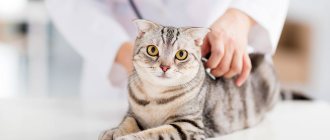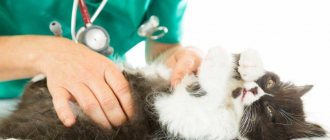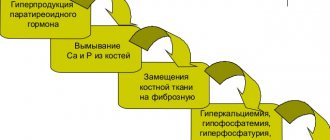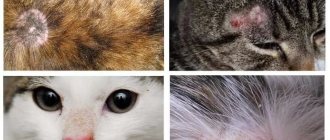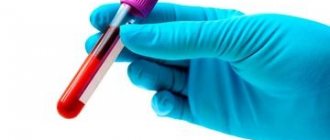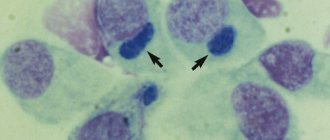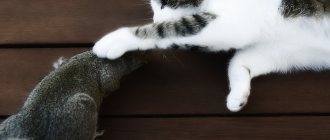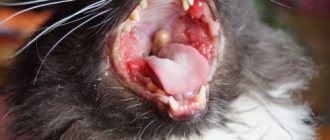What is mastopathy: basic information about the disease
In cats, mastopathy is quite common. This is the name of a specific type of benign tumors, sometimes growing in the thickness of the glandular tissue of the mammary glands. The pathology is accompanied by a change in the shape and consistency of both the nipples themselves and the entire mammary ridge (i.e., a number of mammary gland packages).
Contrary to popular belief, mastopathy is not cancer. But many experts rightly consider it a precancerous condition, noting that advanced cases of this disease in almost all cases end in the development of malignant neoplasms. Therefore, under no circumstances should mastopathy be neglected; when its first symptoms appear, you should immediately seek help from a veterinarian.
Treatment of mastopathy of oncological etiology
There are physiological mastopathy, when the glands become full before the kittens appear, and pathological mastopathy. In the latter case, the causes of the “prenatal” condition can be viruses, bacteria, and cancer. What to do if symptoms of the disease are detected? Contact a veterinarian, as this pathology is extremely dangerous!
Breast augmentation may well be completely painless. In severe cases, characterized by a rapid increase in volume, the organ acquires a reddish-blue color, becomes hot to the touch, and ulcers form (shown in the photo). The cat experiences severe pain and constantly licks the swollen chest. In many cases, the hind legs may also become swollen. A very serious consequence of mastopathy in this case is the high risk of vein thrombosis. Fortunately, this doesn't happen often. These cats can die suddenly from pulmonary thromboembolism (when a broken blood clot simply blocks the pulmonary arteries). Developing secondary infections can lead to septic shock.
Our cats, the pets that many pamper so much, belong to the family of mammals (like humans themselves). The term consists of two words: “milk” and “nourishing”. The decoding is simple - “milk-feeding”. Not all of them, of course, but only the cubs. Alas, the maternal role is not given to animals for nothing: mastopathy in cats alone annually claims many of the lives of our pets.
If this operation was done between the first and second heat, the likelihood of developing mammary cancer is reduced by 25% than in unspayed animals.
Most often, when a disease develops, histology is prescribed. At this stage, the nature of the neoplasm is determined. This study will also tell you how to treat mastopathy in a cat and the possible results of the intervention.
If the tumor is up to two centimeters in size, then its removal is quite possible. In addition, surgery will ensure a complete recovery for the animal.
Well, in cases where the tumor is more than three centimeters in size, it cannot be cured; it simply will not give positive results.
Remember that treating mastopathy in cats at home is unlikely to give results.
Mastopathy in cats is a pre-cancerous disease of the mammary glands, in other words, it is a disease of the cats’ breasts that, as a consequence of its development, leads to a cancerous tumor.
In many cases, mastopathy in cats is fatal without proper treatment.
But mastopathy is not always pathological; the glands also swell for physiological reasons - for example, before the appearance of offspring.
Mastopathy in cats is divided into several types:
We suggest you read: How to make a nest for a Muscovy duck. How to prepare a room and nests for Indo-ducks? Making homemade nests
Differences between mastopathy and mastitis
It is quite simple to distinguish mastopathy from mastitis:
- Mastopathy is a benign tumor, while mastitis is a purely inflammatory disease of the mammary gland.
- Mastopathy (especially in cases where the cat has not been treated) is very often the cause of mastitis. The opposite phenomenon is also possible, but this happens extremely rarely.
- Tumor formation is not the fastest process. Often mastopathy develops during the first pregnancy, but begins to manifest itself clearly closer to the third.
- Mastitis develops immediately and its symptoms are visible already on the second or third day.
Forms of mastopathy in cats
Veterinarians distinguish the following forms of mastopathy in cats:
- Fibrocystic. In this case, multiple “bubbles” (i.e. cysts) filled with fluid appear in the thickness of the mammary gland. Subsequently, they merge and additionally grow with connective tissue.
- Diffuse. In this case, many small compactions form in the thickness of the gland, evenly distributed throughout the organ (usually within one milk bag, i.e. one lobe). Very often this form turns into fibrocystic and there are often no clear gradations between them.
- Juvenile. In general, this is not a separate form of mastopathy, but the age of its manifestation. This is the name of a pathology identified in a young cat before or shortly after puberty (first heat). It can have any form, but in young pets the diffuse type is most often identified.
- Purulent. As a rule, such mastopathy is a consequence of advanced mastitis. Multiple abscesses form in the thickness of the mammary glands, which are subsequently overgrown with connective tissue. Many veterinarians deny the existence of this form of the disease, considering it ordinary purulent mastitis. This is often true: cytological examination of tissue samples does not reveal any traces of a tumor.
Types of disease
An increase in the size of the mammary glands can be both physiological in nature, if the cat feeds kittens with milk, and pathological, leading to modification of the tissues of the organ and the growth of tumors. Based on the location and shape of the formations, nodular and diffuse mastopathy are distinguished.
The first is characterized by the appearance of large compacted areas in one or more glands. They can be filled with liquid or tissue. In the first case we are talking about cystic formations, in the second – about fibroadenoma. Nodular mastopathy is considered by veterinarians as a precancerous condition, since it often provokes the development of a malignant tumor.
Diffuse mastopathy is considered less dangerous, since it practically does not increase the risk of cancer. With this form, multiple small nodules or cysts are formed that do not have clear localization boundaries.
Depending on the characteristics of the course, mastopathy can be:
- Serous. The tissues are saturated with serous fluid. This stage is characterized by the beginning of the modification of normal cells into pathological ones.
- Catarrhal. An inflammatory process occurs in the epithelial and glandular tissues, leading to blockage of the ducts.
- Fibrous. Changes affect intraductal areas.
- Hemorrhagic. Due to the thinning of the walls of blood vessels, hemorrhages occur in the tissues of the organ.
- Purulent. Cavities filled with pus appear inside the gland, which tend to grow. May be complicated by the formation of abscesses.
Reasons for the development of the disease
The exact causes of the development of the disease can be difficult to identify, but most often the pathology is provoked by the following factors:
- Mastitis. One of the most common and typical reasons.
- All types of hormonal pathologies and hormonal “shocks”, which, for example, include the first sexual heat, pregnancy and feeding of cubs.
- Mechanical injuries of the mammary glands.
- Parasites. Nematode larvae often “sleep” in the mammary glands.
- Frequent and prolonged stress (moving, repairs, etc.).
- In recent years, the theory of nutritional mastopathy has been put forward, which, as experts believe, occurs against the background of feeding cheap cereal-based foods. In nature, such food is categorically uncharacteristic for cats, and therefore the response of the animal’s body is difficult to predict.
What is mammary cancer in cats?
Breast cancer in cats is considered to be a group of malignant neoplasms. Animals over 7 years of age are most susceptible to this pathology. However, recently the number of cases of AMF development in young cats has increased.
Separately, it is worth highlighting the presence of mammary gland tumors in cats. The mammary glands of males differ from the breasts of females in the absence of glandular tissue; they consist only of ducts, the inner membrane of which is lined with glandular epithelium. Therefore, in rare cases, cats develop intraepithelial cancer. With this pathology, modified cancer cells do not grow into neighboring tissues, but form in the form of a separate cluster.
Important! Some cats have a rare genetic disease called Klinefelter syndrome, in which glandular tissue is present in the mammary glands. Such males may suffer from mastopathy or malignant breast tumors.
The prognosis of the disease and treatment methods for mammary gland tumors in cats are determined by their type, location, size, stage of development, presence of metastases and some other parameters.
In cats, there are benign and malignant neoplasms of the mammary glands.
Benign tumors are of the following types:
- adenomas;
- duct papillomas;
- fibroadenomas;
- soft tissue tumors.
Among malignant tumors, the most common are carcinomas and adenocarcinomas, which develop from epithelial tissues. The difference is that adenocarcinoma forms only from the glandular tissue of the cat's mammary gland.
Sarcomas that are formed from the soft connective tissue of the gland are recorded much less frequently.
There are nodular and diffuse forms of cancer:
- Nodular tumor occurs in 93% of affected cats. Single formations in the mammary gland occur in 30% of cases, and multiple nodules in 70%.
- The diffuse form is characterized by pathological changes in the entire gland tissue, both with and without a tumor node.
Cancerous tumors in cats are also classified according to their histological structure and the presence of metastases.
AMF is not an infectious disease, so it cannot be transmitted from a sick cat to kittens, other cats or humans.
Scientists put forward theories about a genetic predisposition to malignant degeneration of breast cells and hereditary transmission of cancer from parents to offspring. However, to date there is no exact data that confirms this theory.
Risk groups: which cats get sick most often
There are certain risk groups for mastopathy. Animals related to them get sick noticeably more often:
- Pets during their first heat, first pregnancy, first feeding . As mentioned above, all these periods of an animal’s life are characterized by a sharp change in the hormonal levels of their body.
- False pregnancy. In this condition, the body’s hormonal levels also “go crazy,” which is fraught with many problems.
- Intrauterine death of fetuses or death of kittens in infancy. In these situations, mastitis and subsequent mastopathy are very likely.
- Mastopathy sometimes develops in cases of frostbite or severe hypothermia of the mammary gland (especially in nursing cats).
- Siamese cat breed and crossbreeds based on it.
Important! It is extremely rare, but mastopathy occurs in... cats. Provided that the animal was treated with hormonal drugs for a long time or provided that they were given uncontrolled and unjustified. By the way, most often the same Siamese suffer from this (the treatment is simple - castration).
Causes of development and predisposing factors
The largest number of cancerous tumors in cats are hormone-dependent neoplasms. Therefore, veterinary experts advise owners who do not intend to engage in breeding issues to castrate females before the start of the heat period. The risk of developing malignant tumors ranges from 0.5 to 1%. But with each birth this figure increases, and after the third birth, castration no longer reduces the possibility of cancer.
Other causes of the formation of malignant tumors in cats include:
- injuries and wounds of the mammary glands;
- the use of hormonal drugs to reduce sexual desire;
- untimely treatment of mastitis and mastopathy;
- obesity.
Important! According to statistics, in cats that were given hormonal medications for more than 3 years to suppress the symptoms of estrus, the incidence of mammary and genital cancer was 85%.
Mastopathy in sterilized cats: what causes it to develop
Many breeders know that with sterilization, the risk of cancer and mastopathy is significantly reduced. This is indeed true, but only if the operation was performed before the first heat. It makes sense to sterilize a cat for this purpose before the second or third hunt, after which animals are sterilized exclusively for medical reasons. But in these cases, the procedure no longer saves from mastopathy.
In addition, mastopathy in sterilized cats is a consequence of an incorrectly performed procedure, when for some reason the ovaries or the uterus itself were not removed. You can't do that! Complete sterilization always involves the removal of these organs. Otherwise, hormonal imbalances are inevitable.
Why does breast cancer occur in cats?
Cancer is a common pathology and ranks 4th among all diseases leading to death in cats. The top ten most common types of cancer pathologies include tumors in the mammary glands. Only in 14% of cases are benign growths diagnosed; mostly malignant tumors are detected, which are characterized by an aggressive course, an increased risk of metastasis and a poor prognosis for survival.
Mammary cancer is most common in cats over 10 years of age
Breast cancer occurs mainly due to hormonal imbalances. At risk are nulliparous elderly females during menopause (after 7–10 years). A direct relationship has been proven between the development of cancer and the treatment of animals with hormonal drugs. For example, drugs to suppress the sexual instinct (Antisex, Kovanin, Gestrenol, Stop-Intim, etc.) double the risk of developing tumors. It is much safer to sterilize the animal before the onset of the first heat.
Hormonal drugs for regulating sexual desire are dangerous due to an increased risk of developing malignant tumors
External factors play a role in the development of cancer - lifestyle and environmental conditions. The likelihood of cancer increases with:
- poor nutrition;
- constant stress of the animal;
- influence of radiation.
Predisposing diseases against which tumors often form are:
- atypical hyperplasia of the mammary glands;
- endocrine and metabolic disorders: obesity;
- atherosclerosis;
- diseases of the adrenal glands and thyroid gland.
A genetic predisposition to breast tumors has been identified. Siamese and Oriental cats are most prone to mammary cancer. The culprit is a mutation in the BRCA-1 and BRCA-2 genes. The presence of cancer in a family history is also an alarming sign (breast tumors are often detected in cats whose mothers or grandmothers had cancer of the mammary gland, ovaries, or intestines).
Due to a genetic mutation, Siamese and Oriental cats are most susceptible to breast cancer
Symptoms and first signs of the disease in cats
In order not to miss the moment, you need to closely monitor the cat and, if you detect the first signs of the disease, immediately take the cat to the clinic.
Symptoms of mastopathy:
- Redness of the skin around the nipples.
- The mammary glands may noticeably increase in size.
- Upon palpation, strange lumps, “peas” and other swellings that should not normally be present are easily detected.
- If the disease is already quite advanced, when you press on the affected lobes (as a rule, either 4 or 5 are affected), something vaguely reminiscent of milk (even purulent exudate) is released from the nipples.
- In addition, there may be pain.
- Animals, starting from the second stage of mastopathy, partially lose their appetite, their body temperature may rise, and the mammary glands may also swell, swell and heat up.
- In extremely severe and advanced cases, ulcers may form.
Diagnosis of mastopathy
In most cases, mastopathy is diagnosed as follows:
- An anamnesis is collected, including the presence/absence of the above clinical signs.
- A comprehensive study is carried out: Complete and biochemical blood tests. Firstly, this way you can see signs of inflammation (an increase in the number of leukocytes), and secondly, you can find specific markers in the blood that indicate oncology.
- Ultrasound and radiography of the abdominal and thoracic cavity to confirm/exclude cancer.
- Histological examination of a tissue sample taken from the affected lobe. Often this study is carried out after the operation to excise the foci of mastopathy. This is done in order to confirm or refute possible oncology.
Treatment at home
Let us warn you right away: treatment at home is possible only in mild cases of mastopathy, in its diffuse form and in the first stage. If the disease is advanced, or the animal’s condition is of serious concern, you should always seek help from a veterinarian!
Homeopathic remedies
In some cases, homeopathic remedies help:
- Trauma gel for external use. Relieves swelling.
- Phytoelite-Cytostat. A drug specially created to treat and slow the growth of malignant and benign tumors.
- Mastodinon and Masto-Gran . These medications are specifically designed to treat inflammatory pathologies of the mammary gland.
Important! This therapy helps only in the mildest cases.
Basic medications
In clinical settings, the following drugs are used to treat mastopathy:
- Mastomethrin. Used to suppress inflammatory processes, accelerates the regeneration of damaged tissues.
- Duphaston and Utrozhestan. These are purely medical products, but in veterinary medicine (for lack of analogues) they are also actively used. Essentially, it is synthetic progesterone. This hormone suppresses the further growth of a benign tumor and promotes its resorption.
- Anti-inflammatory corticosteroids , but only after oncology has been completely ruled out! These drugs can stimulate the growth of cancerous tumors.
Compresses for mastopathy
On many resources you can find the opinion that compresses can be used for mastopathy. But that's not true. More precisely, not quite like that. Indeed, at the first stage, you can apply cool varieties of them for 20 minutes with a frequency of once every two hours.
But warming poultices and generally applying heat to the affected lobes is strictly prohibited! Such “treatment” only promotes inflammation and can provoke the transformation of mastopathy into a malignant tumor.
Treatment methods
The treatment prescribed for your cat depends on its age. If an animal is diagnosed with the initial stage of the disease, it can be treated at home. In advanced cases, it should be shown to a veterinarian.
Folk remedies
Mastopathy can be treated with folk remedies. To get rid of redness and relieve swelling, use a cabbage leaf. It must be lightly beaten with a knife, applied to the sore spot and secured with gauze.
Sage and chamomile flowers relieve inflammation well. To prepare the product, take 5 g of raw material, place it in a thermos, pour a glass of boiling water and leave for 3-4 hours. After this, filter. The resulting infusion is soaked into gauze, applied to the mammary glands and secured with a bandage. The procedure should be carried out 2 times a day.
You can prepare a medicinal ointment. To do this, you need to mix alcohol tincture of propolis, lanolin and medical petroleum jelly, which are taken in a ratio of 1:5:5. Soak a napkin in the product, apply it to the sore spot and leave for 4-5 hours.
At home
If a cat that is nursing kittens is sick, you should express the milk and bandage the glands. The pet should be given exclusively dry food and limit water intake. This will reduce milk production.
Treatment is carried out until improvement occurs. If it is suspected that expressed milk has become unsuitable for feeding, kittens should be given alternative food, for example, artificial formula.
The doctor may prescribe novocaine blockades if the pain causes severe suffering to the animal. The procedure is carried out once a day for 3 days. A single injection of a 10% calcium gluconate solution is also given.
Often the veterinarian prescribes homeopathic remedies: Catozal, Mastomethrin or Trauma-gel
If mastopathy in an animal has developed as a result of infection, antibiotics are used: Ampicillin, Cefadroxil. With proper treatment, the pet recovers in 90% of cases.
Surgical intervention
Late stages of the disease are treated surgically. During the operation, areas of tissue of one or more glands that have undergone pathological changes are removed.
If there are indications, all mammary glands are resected. To stabilize the pet's condition, the uterus and ovaries may be removed. This will reduce the estrogen content in the animal’s body.
Surgery to remove the tumor as the most effective treatment method
The experience of veterinarians around the world says that the most effective and efficient treatment method is always surgery to remove the tumor. It is almost useless to treat this pathology with medication, starting from the second stage, and from the third stage such therapy is a pointless waste of time and money.
If the case is not too advanced, it is possible to get by only by removing the affected lobe(s). But! Before this, a thorough ultrasound and x-ray examination is required to ensure that there are no tumors in the adjacent lobes. But in advanced situations, it is often necessary to remove the entire affected ridge (that is, the entire series of lobes), or even all the mammary glands.
The recovery period reaches 4 months (in old animals). In addition, six months after the operation, veterinary control is required at least once a month.
If the cat is not sterilized, six months after removal of the tumor (especially with complete excision of the glands), this operation must also be performed. The pet will still not be able to feed the kittens, so any pregnancy is extremely undesirable and dangerous.
Symptoms of the disease
The insidiousness of breast cancer in cats lies in the fact that the symptoms of the disease appear at stages 3-4, when metastases have already formed and the size of the tumor exceeds 5 cm.
At the first stage of cancer, when the diameter of the lump in the cat’s chest does not exceed 1 cm, the general condition of the body remains unchanged. The animal remains active and has an appetite. An increase in tumor up to 3 cm in the second stage also does not cause discomfort to the cat. At this time, the owner may accidentally discover a lump when stroking his pet’s belly.
In the third stage of cancer, you may notice that your cat's chest is swollen. The diameter of the neoplasm exceeds 5 cm, its surface turns red or darkens, itching and scratching appear. As a result, the animal begins to intensively lick the affected area, which leads to infection of the tumor with pathogenic microflora and the appearance of purulent inflammation. Also, after a cat’s mammary glands become inflamed, wounds and bleeding ulcers may appear in the swollen areas.
At this stage, metastasis of the malignant neoplasm begins, so surgery to remove the tumor does not guarantee a complete recovery.
At the fourth stage, intensive tumor growth is observed, the breast becomes very swollen and inflamed. In addition to these symptoms of cancer in a cat, you can see that the wound has opened and purulent exudate flows out of it with an unpleasant odor of decaying tissue.
The female has:
- general oppression;
- decreased appetite;
- weight loss;
- enlargement of regional lymph nodes.
After a wound opens in a cat with mammary cancer, its condition may worsen with symptoms indicating the development of metastases in other organs. When the liver and pancreas are damaged, signs of digestive disorders and general intoxication appear. The presence of tumors in the lungs is indicated by shortness of breath and cough. Bone cancer causes lameness and fractures.
Possible complications and their consequences
We have already described all possible complications and their consequences, but let’s summarize:
- Very rarely, it is mastopathy that leads to severe mastitis (but usually the opposite is true).
- The most dangerous consequence is oncology. Even though the tumors in mastopathy are benign, there is no guarantee that they will not degenerate into cancer.
- Scar ties on the mammary glands. Even if there are no tumors in the remaining lobes, the cat will most likely no longer be able to feed the cubs.
Prevention of mastopathy
The only true and 100% effective prevention of mastopathy is sterilization of the cat before the first sexual estrus. The remaining recommendations allow not only to reduce the risk of the disease, but to detect it in time:
- Take your pet to the veterinarian at least once a quarter. If the cat is Siamese, then you can do this more often.
- You should not often use hormonal drugs to suppress sexual desire. If getting kittens is not planned in principle, it is better to sterilize the cat immediately.
- You need to feed your pet either high-quality “natural” food or “Premium” and “Super-premium” food classes.
